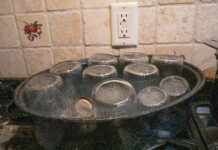UNIVERSITY PARK, Pa. – Researchers at Penn State have devised a new way to clean and disinfect milking equipment using little more than salt water.
The new method could be a safer and cheaper alternative to conventional cleaning systems.
“Concentrated chemicals used in the conventional cleaning are stored on the farm and on contact, they can cause serious burns in the eyes and on skin,” said Ali Demirci, agricultural and biological engineering specialist.
Too much money. And, he said the chemicals are also expensive.
Most farms across the United States use some form of mechanized system to milk cows. Most systems are made of rubber-lined suction cups that milk the cow and transfer the milk to a central refrigerating tank through a series of pipes.
At the end of the day, the whole system is cleaned in a four-step process. First, the pipes are rinsed with warm water to remove the milk. Then they are flushed with a chlorinated detergent at high temperature to remove oils such as fat and protein deposits. A weak acid is used next to neutralize the detergent and remove mineral deposits. Finally, the pipes are sanitized.
Cleaning. Demirci and his colleagues cleaned the milk pipes using electrolyzed oxidizing water, as other researchers had shown its effectiveness in cleaning items like fresh produce and eggs.
Electrolyzed oxidizing water is created when electric current flowing through two electrodes – immersed in a weak salt solution and separated by a membrane – produces an alkaline and an acidic solution.
“It is not as expensive as the detergents, and can be made with just a little bit of salt and water,” Demirci said.
Comparison. To test how the new cleaning agent measured up to conventional detergent, the researchers flushed warm milk laden with bacteria down a series of pipes set up to mimic the system on a farm. Then they compared the cleaning power of both in turns.
In 7.5 to 10 minutes, the electrolyzed oxidizing water was as effective in removing organic matter from the pipes as conventional treatments.
Get 4 Weeks of Farm and Dairy Home Delivered









